INDUSTRIAL HAMILTON: A TRAIL TO THE
FUTURE
History of Industry in Hamilton
Quite early on in Hamilton’s history,
industry became very important to its development. Small industry flourished
and with the advances of the industrial revolution larger and more complex industries
began to be attracted to the Hamilton area. These industries made use of mechanical
developments occurring both in Britain and elsewhere to make trade shop production
lines more efficient.
 One
of the first trades to interest settlers in Hamilton was the early stove trade.
Stoves, which would be used both for cooking and heating the home, were initially
either shipped in pre-assembled, or built in the city from imported parts (plates,
bolts, rods and sheet metal). Eventually, a shift occurred and people such as
Alexander Carpenter began designing and building their own models. Altogether,
five patents on improved stoves were taken out by Hamilton men between 1832
and 1844.
One
of the first trades to interest settlers in Hamilton was the early stove trade.
Stoves, which would be used both for cooking and heating the home, were initially
either shipped in pre-assembled, or built in the city from imported parts (plates,
bolts, rods and sheet metal). Eventually, a shift occurred and people such as
Alexander Carpenter began designing and building their own models. Altogether,
five patents on improved stoves were taken out by Hamilton men between 1832
and 1844.
Aside from the small foundries which
were being built in the city at this early stage in its development, the building
of the Beach
Canal in 1832 made Hamilton the head of navigation on Lake Ontario. Prior
to this, Dundas had been more important than Hamilton as a commercial manufacturing
center, but the lake port created enough competition that Hamilton was soon
attracting more attention than Dundas. By the time that Hamilton was incorporated
as a town in 1833, the population was already nearing 1,000 people.
In 1835, John Fisher and Joseph
Janes, two enterprising mechanics, moved to Hamilton and set up a small furnace.
The men felt that Hamilton would be the ideal location for a furnace, since
it was fairly close to the iron-trade centers of New York. Because they had
a limited amount of money with which to start this venture, Fisher formed a
partnership with his cousin, Calvin McQuesten. The partnership between the three
men specified that the furnace could be used in manufacturing various kinds
of castings. Their main products were plows and threshing machines for farmers,
but stoves and pumps were also produced. Patterns and skilled labour were brought
in from the American iron centers along the Erie Canal and coal was brought
from New York. Iron was imported from Ogdensburg, Rochester, Ohio and Scotland.
Fisher, Janes and McQuesten’s furnace enterprise
did very well and in 1857, McQuesten turned the business over to his nephews,
Luther, Samuel and Stephen Sawyer.
By 1842, Edward
and Charles Gurney arrived in Hamilton to set up their own manufacturing
business. They specialized in potash kettles, parlour boxes, cooking stoves,
ploughs and cultivators. The combined success of the early foundries operated
by Alexander Carpenter, McQuesten and the Gurney
brothers initiated growth in the iron trades.
Hamilton became a city in 1846 and
by 1850 one third of the tonnage entering Burlington Bay through the canal
consisted of iron, with much of it destined for city foundries. Around this
time, machine shops manufacturing precision items, as well as shops that worked
with textiles, came to the region. Richard M. Wanzer
set up an early sewing machine business and William
E. Sanford, an innovator in the industry of ready-made clothes, opened a
shop.
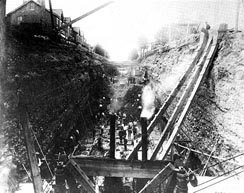 The
beginnings of a new industrial age came to Hamilton with the railway. In 1852,
it was decided that railway lines would run through the city. The iron moulding
and machinist trades grew as foundry men bid to construct roughly 450 railway
cars between the summer of 1852 and 1853. For this, the Great
Western Railway supplied a central steam engine and shafting, and contractors
worked within the railway’s enormous shop, providing their own machinery. Mechanical
equipment was in constant need of repair and new parts, which kept the local
foundries active and lured skilled machinists to the city. Just as the stove
had at one time been the driving force behind industrial growth in Hamilton,
now it was the railway that captured the interests of machinist-inventors who
took out patents for railway improvements. The first Canadian-built railway
locomotives, passenger and freight cars were produced in Hamilton. (Prior to
their manufacture in Hamilton, locomotives had been imported from England and
the United States). Shortly thereafter, the world’s first sleeping car was designed
and manufactured in Hamilton by Samuel Sharpe.
The
beginnings of a new industrial age came to Hamilton with the railway. In 1852,
it was decided that railway lines would run through the city. The iron moulding
and machinist trades grew as foundry men bid to construct roughly 450 railway
cars between the summer of 1852 and 1853. For this, the Great
Western Railway supplied a central steam engine and shafting, and contractors
worked within the railway’s enormous shop, providing their own machinery. Mechanical
equipment was in constant need of repair and new parts, which kept the local
foundries active and lured skilled machinists to the city. Just as the stove
had at one time been the driving force behind industrial growth in Hamilton,
now it was the railway that captured the interests of machinist-inventors who
took out patents for railway improvements. The first Canadian-built railway
locomotives, passenger and freight cars were produced in Hamilton. (Prior to
their manufacture in Hamilton, locomotives had been imported from England and
the United States). Shortly thereafter, the world’s first sleeping car was designed
and manufactured in Hamilton by Samuel Sharpe.
The first train to arrive in Hamilton
came in November, 1853, along the 43-mile leg of the Great
Western line from Niagara Falls. In 1855, work began on the Hamilton and
Toronto Railway Company, making Hamilton a junction for traffic flowing from
north to south and from east to west. On January 17, 1854 the Great
Western rail line from the Suspension Bridge at Niagara Falls to Windsor
on the American border was completed and by the end of 1855, the Hamilton-Toronto
line of the Great Western Railway was opened,
completing the line’s network about the head of the lake. Hamilton was established
as the main terminal of the line and the Great Western
shops established in the city were the first in Canada to manufacture railway
rolling stock.
As the railway expanded into Hamilton,
factories which had at one time been located in the heart
of the city began re-locating near the harbourfront
so that they would have easier access to transport (both rail and water).
By 1857, water power was being used
less-frequently and the steam engine, fuelled by coal, added to the number of
manufacturing industries already in the city. The majority of Hamilton’s manufacturers
were using steam engines to drive their machines. More jobs were created by
the new factories springing up and this coupled with the headquarters of the
Great Western Railway, drew skilled and unskilled
labourers to Hamilton. This rise in population created a demand for more housing.
As well, a wide range of domestic and manufactured goods needed to be produced,
which further stimulated the industry producing them.
With an increase in technological
activity comes the risk of malfunction. An example of this from Hamilton’s past
is the accident
that a Great Western passenger train crossing
the Desjardins canal got into on March 12, 1857.
The 1860’s brought further industrial development to Hamilton. Metalworking
was the most important branch of manufacturing, with textiles being second.
Workshops for the repair of railway tracks were built and the Great
Western Railway constructed Ontario’s first rolling mill in Hamilton. Older
foundries and workshops, such as McQuesten and Sawyer
and Gurney and Company, endured and were expanding
by the time of Confederation in 1867.
Industrial expansion continued into
the 1870’s. Hamilton had developed large-scale industrial plants and working-class
neighbourhoods. During their spare time, the working class took part in activities
such as baseball games, mechanics’ festivals, union balls, commemorative suppers,
picnics and parades. There were also saloons and sporting establishments to
keep citizens busy.
Canada’s first industrial census,
taken in 1871, showed Hamilton having no fewer than seventy-six steam engines
ranging from four to eighty horsepower. The labour force was taken at between
4,500 and 5,000 workers employed in establishments with ten or more operatives.
It was around this time that workers began to voice their opinions on the poor
working conditions in the factories and foundries where they toiled day after
day.
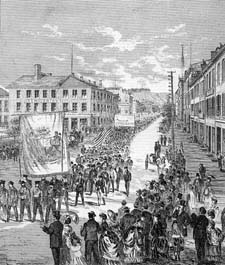 On
January 27, 1872, at a meeting of the Hamilton Mechanics Institute, the Nine-hours
Movement was initiated in Hamilton. A unanimously approved resolution declared
the nine-hours movement to be a matter of social necessity, to enable working
men to improve their educations and better meet their duties as fathers and
citizens. A few employers instituted the nine-hour day out of sympathy, but
144 of the city’s manufacturers and contractors signed a resolution opposing
it in principle. It wasn’t long before workers had either struck or been locked
out at the Sawyer farm implements plant, Wilson,
Bowman and Company (manufacturers of sewing machines) and all but one of the
foundries. On May 15, 1872, Hamilton’s wage-earners marched through the city,
demanding the nine-hour day. They carried colourful flags and banners, with
each group of craftsmen proudly displaying the tools and products of his trade
to those who lined the city streets to watch. It was this sort of display of
spirit which caused other nine-hours leagues throughout southern Ontario to
send delegates to Hamilton to form the Canadian Labour Protective and Mutual
Improvement Association, which was Canada’s first regional labour federation.
In the end though, this left close to 1,000 Hamilton men out of work. By the
summer of 1872 many of these workers realized defeat and drifted back to their
old jobs. Any shops which had instituted the nine-hour day switched back to
ten hours.
On
January 27, 1872, at a meeting of the Hamilton Mechanics Institute, the Nine-hours
Movement was initiated in Hamilton. A unanimously approved resolution declared
the nine-hours movement to be a matter of social necessity, to enable working
men to improve their educations and better meet their duties as fathers and
citizens. A few employers instituted the nine-hour day out of sympathy, but
144 of the city’s manufacturers and contractors signed a resolution opposing
it in principle. It wasn’t long before workers had either struck or been locked
out at the Sawyer farm implements plant, Wilson,
Bowman and Company (manufacturers of sewing machines) and all but one of the
foundries. On May 15, 1872, Hamilton’s wage-earners marched through the city,
demanding the nine-hour day. They carried colourful flags and banners, with
each group of craftsmen proudly displaying the tools and products of his trade
to those who lined the city streets to watch. It was this sort of display of
spirit which caused other nine-hours leagues throughout southern Ontario to
send delegates to Hamilton to form the Canadian Labour Protective and Mutual
Improvement Association, which was Canada’s first regional labour federation.
In the end though, this left close to 1,000 Hamilton men out of work. By the
summer of 1872 many of these workers realized defeat and drifted back to their
old jobs. Any shops which had instituted the nine-hour day switched back to
ten hours.
The mid-1870’s were a time of economic
downturn. Despite several hundred residents leaving the city, industrial progress
continued. The first street railway company, which
was formed in 1873, launched it’s first horse-drawn cars from their depot on
Stuart Street in May, 1874.
During this time period, there was great experimentation
with new technology, some of which lead to such idiosyncratic inventions as
Adam Ironsides, the Steam Man, by Cyrus C. Roe who
is listed in Hamilton city directories as both a machinist and a showman between
1875 and 1878. It is unknown whether this invention ever really saw the light
of day.
In the late 1870’s, the Great
Western shop was leased by American businessmen from the iron regions of
Ohio to become the Ontario Rolling Mills Company. Uniting with the Hamilton
Steel and Iron Company on Huckleberry Point, the combined works became the
Hamilton Steel and Iron Company, a nucleus of the later
Steel Company of Canada Limited.
During the 1880’s, the federal government
instituted a general policy, encouraging and protecting Canadian industries
from the foreign market, and the enlarging of the Welland Canal in 1887 permitted
larger boats from the Upper Lakes and Erie to enter Lake Ontario. This encouraged
the development of Hamilton’s metal industry. With the absorption of the Great
Western Railway by the Grand Trunk in 1882,
the company’s offices were moved to Montreal and its workshops in the city were
closed down. The Toronto, Hamilton and Buffalo Railway
originated not long after this, in response to the lack of freight competition
after the Great Western was absorbed.
The first major step toward a trade
union for Hamilton workers was with the Knights of Labor. The Nobel Order of
the Knights of Labor began in 1869 as a small secret society of Philadelphia
garment cutters. The Order rapidly spread throughout North America to Britain
and Australia, claiming more than 700,000 members at its peak. Based on the
model of secret societies such as the Masons, it was particularly active on
several fronts. It wasn’t until the 1880’s, however, that the Knights of Labor
surfaced in Hamilton.
One night in 1881, 40 painters met in an
unfinished Hamilton building to form Canada’s first active assembly of the Knights
of Labor. Unions had only recently won legal status and employers’ opposition
made secrecy a necessity. The Knights sense of class led them to accept both
skilled and unskilled workers, including women and blacks. Their motto was,
“An injury to one is the concern of all.” To promote their views, they produced
newspapers, first The Labor Union and later the Palladium of Labor. They believed
that political action was the best route for social change. The Knights of Labor
gained a strong following in Hamilton, leading the most successful attempt at
uniting Hamilton working people in the 19th century. Its members
included important figures, such as Members of Provincial Parliament and future
mayor of Hamilton, John
Peebles. His reminiscences paint an interesting
picture of what the Knights of Labor were like to him.
In December, 1886, a commission was appointed by the Governor
General of Canada to investigate various matters
relating to labour.
On December 3, 1888, the Hamilton Trades
and Labor Council was formed. Its first president was William Derby of the Knights
of Labor. Craft unions were soon competing with the Knights of Labor for representation
of skilled workers. Some conflict ensued and by the end of 1888, Knights’ membership
in Hamilton had evaporated.
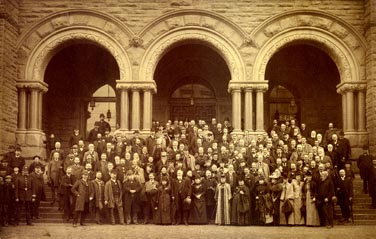 In
order to encourage the continued growth of industry, the City Finance Committee
recommended in 1890 that all manufacturers locating in Hamilton should be exempted
from paying taxes on their buildings, machinery, tools, income and personal
property for 10 years. This encouraged manufacturers to locate in the city,
which in turn added to the population and economic well-being.
In
order to encourage the continued growth of industry, the City Finance Committee
recommended in 1890 that all manufacturers locating in Hamilton should be exempted
from paying taxes on their buildings, machinery, tools, income and personal
property for 10 years. This encouraged manufacturers to locate in the city,
which in turn added to the population and economic well-being.
By 1891, there were a considerable
number of highly organized and specialized plants located within the city. This
included rolling mills and other plants for the making of nails, tacks, screws,
wire, agricultural machinery, engines, boilers, bridges, tin cans, elevators,
axles, wheels, canned foods and cotton goods. These larger manufacturers were
successful to the point that by the end of the 1890’s, smaller factories and
workshops were finding it difficult to compete with the large mechanical factories
and their mass-produced goods.
The Cataract Power Company assembled
a hydro-electric generating plant about 35 miles from Hamilton in 1898. Current
flowed to the city for the first time on August 25, 1898. This new system, which
was less-expensive than the steam and thermal electricity generated in Toronto,
provided power to the city’s industrial users, as well as to street lights and
the electrified streetcar system. It was the first major electric power service
for industry in Canada.
The advent of electrical power had
a great impact on the architectural design of industrial factories and plants.
This was an advantage to the workers in these factories, since lower ceilings
could be put in, which created better lighting. New factories could be a single
storey tall, instead of three. As well, there was better ventilation, making
it easier for the workers to breathe and also creating safer working environments.
1899 was a busy year for industry
in Hamilton. It was during this year that a dedicated industrial belt line was
constructed in the city. Also, a blast furnace was purchased by the Ontario
Rolling Mill and the resulting new corporation was the Hamilton
Steel and Iron Company, which had an open-hearth facility and an extensive
product line. Their first open-hearth steel was produced on June 15, 1900. The
locating of a primary iron and steel plant, the coming of the Toronto,
Hamilton and Buffalo Railway and the Canadian Pacific Railroad, and the
tax exemptions offered by the city had a direct impact on industrial growth
in Hamilton.
 In
1899, the Cataract Power Company changed its name to the Hamilton Electric Light
and Cataract Power Company Limited. The following year it took over control
of the Hamilton Street Railway and the Hamilton
Radial Railway. In 1903, the company was incorporated as the Hamilton Cataract
Power, Light and Traction Company Limited.
In
1899, the Cataract Power Company changed its name to the Hamilton Electric Light
and Cataract Power Company Limited. The following year it took over control
of the Hamilton Street Railway and the Hamilton
Radial Railway. In 1903, the company was incorporated as the Hamilton Cataract
Power, Light and Traction Company Limited.
The years from 1900 to 1913 came
to be known as a time of “Laurier prosperity.” During the early 1900’s, many
manufacturers were setting up around an industrial complex on Sherman Avenue.
The land was relatively inexpensive and the location was close to a source of
steel. Companies that chose to locate in this area included the Canada Steel
Goods Company, the Frost Wire Fence Company, the Banwell-Hoxie Wire Fence Company,
the London Machine Company, the firm of F. W. Bird, the Standard Underground
Cable Company, the Atkins Saw Company and the Oliver Chilled Plow Company.
By 1901, the population had nearly
doubled from 26,900 residents in 1871 to 52,700. As more metal industries were
established in the city, workers asked for and received an increase in wages.
By 1906, however, the city saw one of its most violent strikes ever, over a
dispute between the Cataract Power, Light and Traction Company and its employees
at the Hamilton Street Railway.
In 1907, the Independent Labour
Party (I.L.P.) was founded, serving as political opposition to the city’s Conservative
machine. A typical platform of the I.L.P.’s moderate leadership advocated the
eight hour day, free compulsory education, improved government factory inspection,
minimum wages based on local conditions, public ownership of utilities, abolition
of child labour (those under 14), exclusion of Asiatics, abolition of bonuses
to steamship companies aiding European immigration, and old-age pensions.
Between 1910 and 1912, Hamilton
saw an extraordinary amount of industrial construction. The Steel
Company of Canada was formed in June, 1910 by the incorporation of five
existing companies (two of which were in Hamilton). By this time, more capital
was being invested in hydroelectric schemes and the power of the Niagara River
was being harnessed, leaving Hamilton with the lowest power costs of any large
Canadian city.
In 1912, Clifton W. Sherman, an
American with a background in the iron and steel industry, established a new
steel foundry, Dominion Steel Castings Limited, in Hamilton. This foundry would
go on to become one of the city’s leading industries, Dominion
Foundries and Steel Limited (Dofasco). In December, 1912, the foundry poured
its first heat of steel.
The Chipman, Holton Company Limited
became, in 1912, the city’s first hosiery manufacturer. They knitted plain cotton
stockings in brown and black for women. Add this manufacturer to the city’s
earlier established yarn sales and textile mills, the later T. Eaton Knitting
Mill (established in 1916), the Mohawk Mills (established in 1932) and the National
Hosiery Mills, former makers of Phantom Hose, and Hamilton’s title of Ontario
textile capital, held for several decades, is understandable.
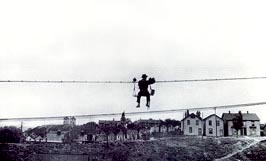 Manufacturing,
which had prospered in Hamilton, was slowed when a serious recession struck
the North American economy in 1913. This particular recession was especially
hard on the heavy industry located in Hamilton. Hardware producers and farm-implements
manufacturers reacted to the decrease in orders by closing plants or putting
men on short time. Hundreds of moulders were out of work, leaving an estimated
2,500 unemployed during the winter of 1913-1914. With the outbreak of World
War I, recession turned to depression. Luckily for Hamilton, though, Canadian
metal manufacturers were saved by the need for munitions.
Manufacturing,
which had prospered in Hamilton, was slowed when a serious recession struck
the North American economy in 1913. This particular recession was especially
hard on the heavy industry located in Hamilton. Hardware producers and farm-implements
manufacturers reacted to the decrease in orders by closing plants or putting
men on short time. Hundreds of moulders were out of work, leaving an estimated
2,500 unemployed during the winter of 1913-1914. With the outbreak of World
War I, recession turned to depression. Luckily for Hamilton, though, Canadian
metal manufacturers were saved by the need for munitions.
By spring, 1915, World War I orders
and enlistments cut into the unemployment facing the city. Industries with shell
contracts operated day and night shifts when the government announced that it
needed as many shells as could be produced. Employment in iron and steel trades
rose from 4,300 to 9,400 across Ontario between January and December, 1915.
In foundries and machine shops, the increase was from 9,000 to 13,000 workers.
Virtually all industries with war contracts declared high returns of profit
during World War I, but the Steel Company of Canada
was confirmed as Hamilton’s industrial giant during this period. The company
built the first coke oven battery and added a coal and ore dock to Hamilton’s
industrial waterfront during this time. Hamilton Firestone
also did quite well during World War I, as the largest producer of tank track
wheels in the Commonwealth. They also produced military tires and bullet-sealing
fuel cells for aircraft.
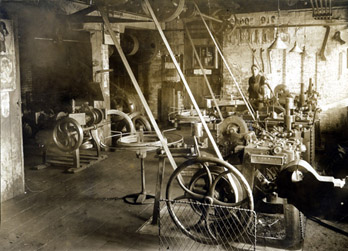 Following
the war, industrial growth continued in Hamilton. This was partially due to
low electric power rates in the city. By 1920, Dofasco
had diversified into flat rolled steel, while Proctor
and Gamble was kept in business through the low periods by the demand for
a simple household item: soap. Hamilton was headquarters to the largest canning
corporation in the British Empire and was also producing 38% of all wire products
manufactured in Canada. By 1926, the city had emerged as the third largest manufacturing
center in Canada, serving as a home for more than 500 industries.
Following
the war, industrial growth continued in Hamilton. This was partially due to
low electric power rates in the city. By 1920, Dofasco
had diversified into flat rolled steel, while Proctor
and Gamble was kept in business through the low periods by the demand for
a simple household item: soap. Hamilton was headquarters to the largest canning
corporation in the British Empire and was also producing 38% of all wire products
manufactured in Canada. By 1926, the city had emerged as the third largest manufacturing
center in Canada, serving as a home for more than 500 industries.
During the 1920’s, the radial era
flourished. By the end of the decade, however, trolley cars were gradually being
replaced by gas-powered street buses. On June 30, 1931 the last radial car ran
on the Brantford-Hamilton line. The radial age had ended. Old trolley cars went
to junkyards, tracks were torn up and the terminal was converted into a bus
depot and office building.
By 1929, the beginning of the Great
Depression, Hamilton had 36,000 wage earners. In only four years and as the
Depression reached its worst, there were only 22,000 wage earners in the city.
It would take until 1937 for the number of wage earners to reach 36,000 again.
Unfortunately, as labour increased and longer work hours were introduced, industrial
accidents occurred more frequently. This led workers to seek union protection
and on November 6, 1941 the Hamilton Labour Council was formed.
Prior to 1943, there was no legal
provision for Canadian workers who joined unions, nor were companies obliged
to recognize a duly certified union as the employee’s bargaining agent. In fact,
most union organizers were fired, most forms of picketing were illegal and union
security was, for the most part, non-existent. In January, 1943, the federal
government altered its policy by making mandatory a set of guidelines which
included the right of workers to form their own unions.
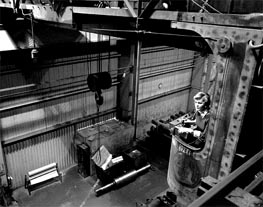 As
World War II began, industrial production increased quite heavily, just as it
had during the previous war. The strong textile industry turned out such items
as uniforms and tents. The steel industry was also kept quite busy during this
period. As men enlisted to fight in the war, women took their places in the
factories. A large number of labourers came to Hamilton during this period,
seeking employment in the war industries and setting up homes where they could
raise their families.
As
World War II began, industrial production increased quite heavily, just as it
had during the previous war. The strong textile industry turned out such items
as uniforms and tents. The steel industry was also kept quite busy during this
period. As men enlisted to fight in the war, women took their places in the
factories. A large number of labourers came to Hamilton during this period,
seeking employment in the war industries and setting up homes where they could
raise their families.
Following the war, the economy experienced
only mild fluctuations. Steel companies expanded tremendously with new product
lines, additional mills and furnaces employing state-of-the-art technology.
This expansion paralleled growth in the appliance and automotive industries
which relied heavily on tin plate and annealed steel.
The summer of 1946 was a time of
labour disputes in Hamilton, as workers struggled for industrial and political
democracy. On July 15, 1946, workers at Stelco
began what was to the be the largest strike in the company’s history. Numerous
other plants and shops, both in Hamilton and outside of the city, were also
facing strikes at this time. Outside of the Stelco
plant, war veterans gathered alongside workers from Stelco,
Westinghouse and Firestone,
taking part in picket lines which eventually turned violent. The Ontario Provincial
Police and Royal Canadian Mounted Police were called in to help on August 25th
and by early October the strike was brought to an end.
By the mid-1950’s, Hamilton’s textile
industry was dwindling. Textile plants were finding it difficult to keep operations
running to the extent that they once had, and as a result many either closed
shop, hired fewer labourers, or relocated. The steel industry, by contrast,
continued to expand, which actually began to raise some controversy by the 1960’s,
as Hamiltonians became more environmentally aware. Pollution from the major
steel plants of Stelco and Dofasco
was causing a stir and studies were done to determine the effects that this
pollution was having and to try and determine how to clean it up. Eventually,
special pollution filters were put to use and safer processes were developed
for dealing with the raw materials used to create steel.
In 1973, a Hamilton-based advertising
firm, the Russell T. Kelley Company, Limited, printed a promotional
advertisement praising Hamilton's industrial heritage and dismissing the
reputation which Hamilton had gained as a "lunch bucket" town.
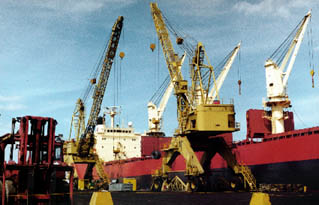 Throughout
the 1970’s, 1980’s and 1990’s, industries continued to progress, with few labour
disputes. In what some are calling a new industrial revolution, companies have
turned to advanced computer technology for precision, automation and efficiency
in the factory. In 1991, Stelco teamed-up with
Tokyo-based Mitsubishi Corporation to develop their advanced “z line” while
Dofasco turned to laser welding and purchased Powerlasers
Limited in 2000. The move toward technology-based industry is well-reflected
in Wescam Incorporated, founded in 1974, which specializes
in wireless visual information systems for government and commercial customers.
The new millennium is seeing rapid changes as technology takes over more of
the traditional industrial base. Industry in the future will probably bear no
resemblance to the labour-intensive industry of Hamilton’s early industrial
age. Only time will tell.
Throughout
the 1970’s, 1980’s and 1990’s, industries continued to progress, with few labour
disputes. In what some are calling a new industrial revolution, companies have
turned to advanced computer technology for precision, automation and efficiency
in the factory. In 1991, Stelco teamed-up with
Tokyo-based Mitsubishi Corporation to develop their advanced “z line” while
Dofasco turned to laser welding and purchased Powerlasers
Limited in 2000. The move toward technology-based industry is well-reflected
in Wescam Incorporated, founded in 1974, which specializes
in wireless visual information systems for government and commercial customers.
The new millennium is seeing rapid changes as technology takes over more of
the traditional industrial base. Industry in the future will probably bear no
resemblance to the labour-intensive industry of Hamilton’s early industrial
age. Only time will tell.
References:
- Campbell, Majorie Freeman. A Mountain and a City.
- Clipping File - Hamilton - Industry - Industrial Commission. Special Collections,
HPL.
- Evans, Lois C. Hamilton - The Story of a City.
- Hamilton: The City Beautiful and Industrial Hub of Canada. Department of
Industries and Publicity, 1900.
- Hamilton Description Scrapbook. Vol. 2. Special Collections, HPL.
- Heron, Craig. All That Our Hands Have Done: A Pictorial History of the Hamilton
Workers.
- Katz., Michael B. The People of Hamilton, Canada West.
- Roberts, R. D. The Changing Patterns in Distribution and Composition of
Manufacturing Activity in Hamilton Between 1861 and 1921.
- Thomson, Thomas M. Hamilton City Sketches.
 One
of the first trades to interest settlers in Hamilton was the early stove trade.
Stoves, which would be used both for cooking and heating the home, were initially
either shipped in pre-assembled, or built in the city from imported parts (plates,
bolts, rods and sheet metal). Eventually, a shift occurred and people such as
Alexander Carpenter began designing and building their own models. Altogether,
five patents on improved stoves were taken out by Hamilton men between 1832
and 1844.
One
of the first trades to interest settlers in Hamilton was the early stove trade.
Stoves, which would be used both for cooking and heating the home, were initially
either shipped in pre-assembled, or built in the city from imported parts (plates,
bolts, rods and sheet metal). Eventually, a shift occurred and people such as
Alexander Carpenter began designing and building their own models. Altogether,
five patents on improved stoves were taken out by Hamilton men between 1832
and 1844.






